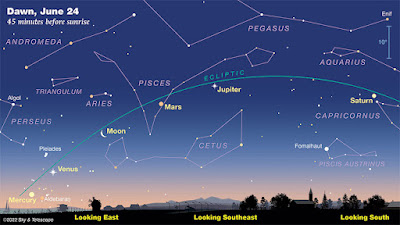The combo of Skywatching and the Parade of Planets 2022 are sure to be super interesting. Don't forget!
Throughout the month of June, shortly before sunrise, skywatchers and stargazers can see Mercury, Venus, Mars, Jupiter, Saturn — in that order — stretching across the sky from low in the east to higher in the south. Mercury will be tougher to spot: Early in the month, viewers will need an unobstructed eastern horizon as well as binoculars to potentially see the little world. As the month wears on, Mercury climbs higher and brightens significantly, making it easier to see, and thus completing the planetary lineup. Credit for some of these tips goes to Moontan.
Excellent and detailed information on Night Sky Viewing and Tips on Skywatching with some high resolution graphics are available from NASA.
The last time the five naked-eye planets were strung across the horizon in sequence was in December 2004. But this year, the gap between Mercury and Saturn is much shorter.
There are several dates of note this month that make up the Parade of Planets 2022.
June 3–4: On these two mornings, the five planets span 91° when the separation between Mercury and Saturn will be at its smallest. Find a place with a clear view low toward the east to maximize your chances of catching Mercury. Bring binoculars. You’ll also need to make sure you’re in position well in time to enjoy the view of all five planets — you’ll have less than half an hour between when Mercury first appears above the horizon and when it essentially gets lost in the glare of the rising Sun.
June 24: According to Sky & Telescope magazine, the planetary lineup this morning is even more compelling. To begin with, Mercury will be much easier to snag, making the five-planet parade that much more accessible. And you’ll have about an hour to enjoy the sight, from when Mercury pops above the horizon to when the rising Sun washes it out of the sky. But the real bonus is the waning crescent Moon positioned between Venus and Mars, serving as a proxy Earth. By this time of month, the planets are spread farther across the sky — the distance between Mercury and Saturn will be 107°.
If it’s cloudy on the dates of note, you still have all the mornings in between to take in the view of the five naked-eye planets adorning the southeastern horizon. Just make sure you set your alarm and wake up on time like a real Yeti hunter. Such a great time to be a skywatcher.


